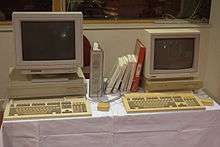RISC iX
RISC iX is a discontinued Unix operating system designed to run on the Acorn Archimedes.[1] Heavily based on 4.3BSD, it was initially completed in 1988 – a year after Arthur but prior to RISC OS.[2]
 RISC iX running on the Acorn A680 | |
| Developer | Acorn Computers Ltd |
|---|---|
| OS family | Unix-like |
| Working state | Historic |
| Initial release | 1988 |
| Platforms | Acorn Archimedes |
| Default user interface | Graphical user interface |
Features
- X11 (initially Release 2) with Ardent Window Manager, Tom's Window Manager and Ultrix Window Manager available by default
- System V virtual memory extensions, compatible with the "System V Interface Definition"
- C Compiler with ANSI C and pcc (Berkeley) compatibility
- Sun Network File System version 3.2
- ARM Assembler
Later versions upgraded the X11 server to release 4, and was certified to conform to the X/Open Portability Guide 3 Base profile.
The native file system implemented a transparent executable file compression mechanism that took advantage of the hardware's 32 KiB page size and sparse files. Additionally, the console featured a two-cursor text copying mechanism inspired by Acorn's own earlier 8-bit range including the BBC Micro.
Distribution
RISC iX was either supplied preinstalled on new computer hardware or was installed onsite from a portable tape drive by Granada Microcare, who would take the installation tape away with them. The cost of purchase was £1,000.
Once installed a backup of the core operating system to three floppy disks was possible, allowing future reinstallation.
Supported hardware
Machines

M4
An unreleased machine, built internally by Acorn for the development of RISC iX. Reputedly only three were built and one of them has subsequently been destroyed. All known examples are owned by The National Museum of Computing.
A680 Technical Publishing System
Unreleased but widely prototyped, the A680 contained an ARM2 processor, 8 MiB RAM (dual MEMCs) and a 67 MB hard drive running from an onboard SCSI controller (no other machine from Acorn Computers included integrated SCSI). It is rumoured that overheating from the SCSI controller was one reason for the machine to never be released.
R140
Based on the A440/1, the R140 contained an 8 MHz ARM2 processor, 4 MiB RAM and a 47 MiB, later upgraded to 56 MiB, ST506 hard drive. Supplied with RISC OS 2 in ROM, the machine would boot that OS then could either automatically boot RISC iX totally removing RISC OS from memory or continue running RISC OS – optionally being rebooted into RISC iX at any time.
At the time of initial release in 1989, the cost of the R140 was £3,500.
An ordinary A440/1 with at least 4 MiB RAM and a suitable hard drive could run RISC iX. The R140 and A440/1 were hampered by the memory management unit (MMU), using 32 KiB pages.
R260
Based on the A540, the R260 originally contained a 26 MHz, (later 33 MHz) ARM3 processor, 4 MiB RAM (upgradable to 16 MiB) SCSI adapter and a 100 MB SCSI hard drive (typically a Conner CP30100). It booted in the same style as the earlier R140. The machine was supplied with an Ethernet adapter.
The system was released in 1990 priced at £3,500 as its predecessor had been.
A similarly configured A540 could run RISC iX.
R225
The R225 was a diskless version of the R260. It required a network file server or an R260 to boot.
Later machines
RISC iX is not compatible with later Archimedes machines.
Peripherals
As well as industry-standard Ethernet, Acorn's own Econet was supported, including an IP over Econet transmission system.